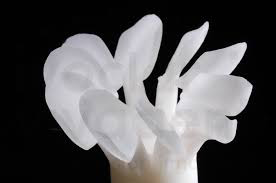
Currently, the most widely used and the strongest and toughest dental glass–ceramics are LD glass–ceramics. This class of glass–ceramic was commercialized for dental framework use and marketed under the trade name IPS Empress 2 in 1998 by Ivoclar Vivadent. However, IPS Empress 2 LD glass–ceramics had high clinical failure rates at 9% to 50% after 24 to 60 months [63], because of the insufficient flexural strength of this material for multiunit prostheses. Subsequently, a new and improved LD glass–ceramic (IPS e.max) with a much higher flexural strength (up to 400 MPa) was launched and the material gained popularity [14,15]. The IPS e.max LD glass–ceramics come in two forms, Press and CAD. IPS e.max Press is processed in the dental laboratory using the well–known lost–wax technique [14]. This technique is distinguished for providing high accuracy of fit.
As mentioned in 4.1, IPS e.max CAD was introduced in 2006 as an LD glass–ceramic, specifically prepared for CAD/CAM soft milling [15]. The material comes prepared in a “blue state,” which permits easier machining and intraoral occlusal adjustment [64]. In the “blue state,” the crystalline phase is lithium metasilicate (Li2SiO3) [65]. Once milling has been completed, the restoration is subjected to the second round of heat treatment, in which lithium metasilicate (Li2SiO3) reacts with the glass phase (SiO2) to form LD (Li2Si2O5), which is much stronger and tougher than the Li2SiO3. This is the so-called “soft milling,” that effectively reduce the wear of milling tool compared to “hard milling” (direct milling of sintered blocks). Figure 8c demonstrates the typical interlocked microstructure of LD glass–ceramic. The interlocked microstructure produces a high flexural strength that may reach up to 400 MPa and a fracture toughness up to 3 MPa·m1/2, which allows the use of LD as single restorations anywhere in the mouth and as short–span FDPs in the anterior region [14,44,66]. In addition to their good mechanical strengths, LD glass–ceramics also show advantages over other dental glass–ceramics in terms of adjustable shade and translucency. For instance, IPS e.max CAD is available in the standard A through D shades and also includes a line of bleach shades [44]. The color of the material can be adjusted by the content of the crystalline phase and also by colorant ions dispersed in the matrix. The primary ions consist of V4+/V3+ (blue/yellow), Ce4+ (yellow), and Mn3+ (brown) [15]. Besides, IPS e.max CAD also comes in three levels of translucency, medium opacity (MO), high translucency (HT), and low translucency (LT). This variation is accomplished via adjusting the crystal sizes with HT glass–ceramic exhibiting crystals of 1.5–0.8 mm, whereas LT glass–ceramic exhibits smaller crystals (0.8–0.2 mm) in a higher density [44].


Leave A Comment